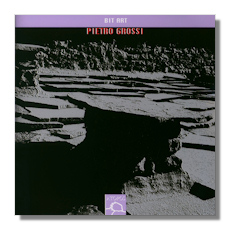
The Internet's Premier Classical Music Source
Related Links
- Latest Reviews
- More Reviews
-
By Composer
-
Collections
DVD & Blu-ray
Books
Concert Reviews
Articles/Interviews
Software
Audio
Search Amazon
Recommended Links
Site News
 CD Review
CD Review
Pietro Grossi

Bit Art
- Quartetto (1957) 1
- Composizione No 5 (1959) 2
- Composizione No 6 (1960) 3
- Studio da 'Tre Pezzi' (1960) 4
- Composizione No 11 (1961) 5
- Composizione No 12 (1961) 6
- Create C (1972)
1,3,6 Quartetto Elisa
2 Marco Martell, double bass
2 Marco Mazzinghi, double bass
2 Stella Sorgente, double bass
4 Andrea Nannoni, cello
5 Donatella Debolini, voice
5 Giancarlo Cardini, piano
6 Pietro Grossi, programming
Atopos ATP016
Pietro Grossi (1917-2002) is an Italian composer with the (sounds of) strings in his blood. Trained as a cellist and composer, he had a successful and distinguished solo performing career, was a respected and prominent teacher and innovator with electronic music and the celebration of modern music through festivals, orchestral projects and research. The present CD from the groundbreaking and ever-enterprising Italian Atopos label contains seven examples of his earlier instrumental music with the last item only, Create C, from 1972, for synthesized resources.
Yet the meticulous playing and variety of genres, the intimate (and just as open) acoustic of Bit Art provide a good springboard from which to examine Grossi's concerns with digital sound. If music is all vibration, and the esthetics of music is essentially the sonorities of vibration, the strings in general and the cello in particular can be considered an excellent environment in which to explore the innate nature of (that) sound. It concentrates the listener's mind on vibration and on resonance, and on their place in time&nellip; when vibration becomes beat, when the boundaries between modulation and vibration blur – something that concerned Xenakis too, of course. Grossi's world, in this respect, is not too unlike that of, say, Morton Feldman's. Much of Grossi's music has the quality of great deliberateness; though is never labored.
In fact, this CD shows ways in which not only the string quartet (the Quartetto Elisa appears in three of the works here), but also the three double basses of Marco Martell, Marco Mazzinghi and Stella Sorgente and music for voice and piano (Donatella Debolini and Giancarlo Cardini respectively) as well as Andrea Nannoni's cello all answer questions about these relationships between time and tone. The commitment and spontaneity of these musicians is evident from first note to last on this CD. The music is always accessible and in generally melodically pleasing. This aspect – and considerations of ways in which sound is produced – are uppermost in their performance, though not exclusively so. They have sufficiently well absorbed the essence of Grossi's ideas for this to be music first, and inquiry only secondarily.
Another theme of Grossi's musical concerns was that the computer is key to allowing those previously without access to the means to make music explore and create for themselves. Much of Grossi's later life was spent in electronic (and latterly internet) publishing and exploration. These are alluded to briefly in the fairly short booklet that comes with the CD. Interestingly, the register of the music here prefigures the mix that digital origination sponsors between discrete units of music and consistency (which is not the same as homogeneity) of command in realizing the musical ideas synthetically. Music arrived at without necessarily being performed in the more conventional senses of the term. Yet music with structure.
Most of the pieces are relatively short. There is an economy, a concentration on what it is to experience the sounds which the instruments make, that is very striking to the listener. Composizione No 6 [tr.7], for example, from 1960, has its focus on the very nature of slow, deliberate string sound where intervals and even harmony are at times all but incidental… listen, too, to the measured and tight study from 'Tre Pezzi' (1960) [tr.8]. Grossi's delight in the mechanics of horsehair on gut (etc) is evident. Not, though, that this is dry or pointlessly casual exploration. There is structure in the way that Berg, rather than Webern, knew structure. The same applies in the case of the one vocal work here, Composizione No 11 (1961). The voice uses word-free vocalizations to suggest the quiet power of vowels and vowel sounds.
These descriptions may give the impression that Grossi's music is experiment first and euphony second. Not so. There are several aspects of his music, his sound world and his priorities, that are speculative for sure. But they are neither self-serving, nor tentative to the point when (listening to) his music is an exercise. There is real beauty and convincing direction in the works on this CD. Its concentration on the composer's earlier, largely instrumental, works is apposite if for no other reason than that it whets one's appetite for the electronic work that followed. In fact, Create C (1972) gives something of an idea of that. It's very much of its times – written nearly 40 years ago – and pursues some of the same paths as the other works on this CD. In particular, Grossi's pre-occupation with simple, at times unadorned, sounds (sine waves for example) both in combination and standing alone. The concentration on the essence of the sounds goes a long way to defeating awareness of melodic development, rhythm and structure, in ways redolent of where Stockhausen had been succeeding the decade before. Though Grossi's work has less drive or awareness of its own novelty and challenge.
If the Italian avant garde intrigues you and/or if you want to remind yourself which roots of exploratory contemporary European music led where, this pleasing collection of pieces which exude self-confidence and feet planted firmly in reality and some of those roots' strongest and thickest skeins, take a look at Bit Art.
Copyright © 2011, Mark Sealey.












